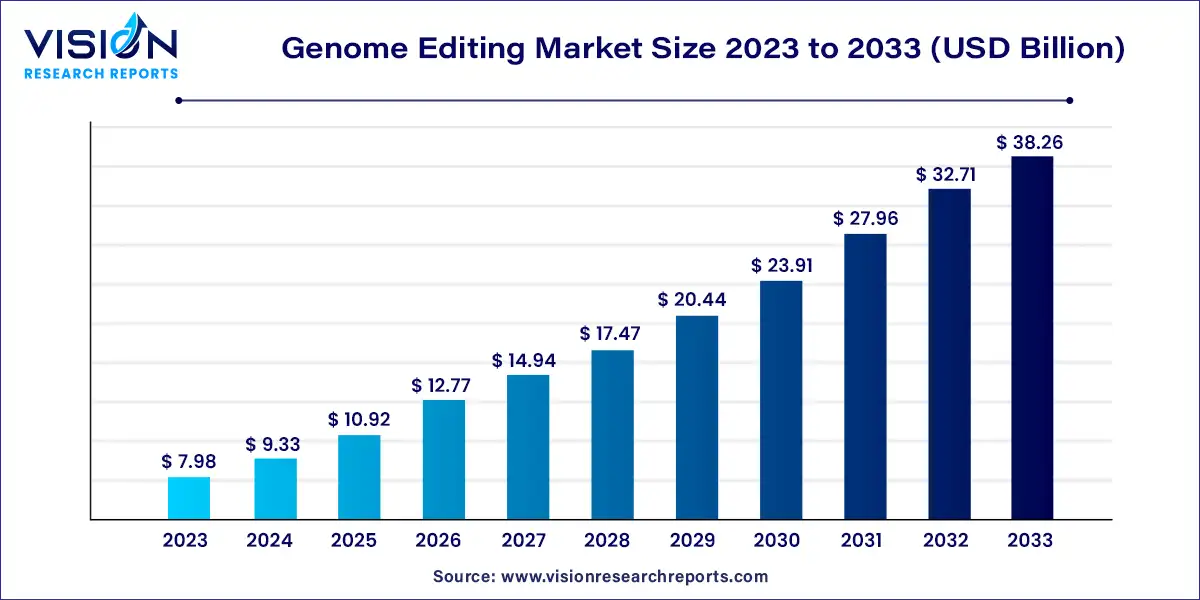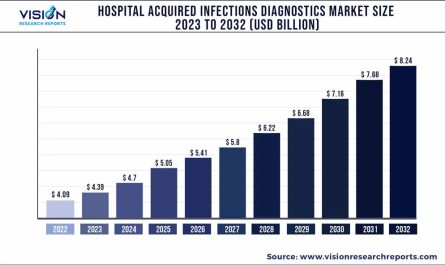The global genome editing market size was estimated at USD 7.98 billion in 2023 and is expected to surpass around USD 38.26 billion by 2033, poised to grow at a CAGR of 16.97% from 2024 to 2033.
Genome editing refers to the precise alteration of an organism’s DNA using molecular scissors such as CRISPR-Cas9, TALENs, or zinc finger nucleases. This technology allows scientists to modify genes with unprecedented accuracy, offering vast potential for therapeutic interventions, agricultural enhancements, and research advancements.

Key Pointers
- North America led the market with the largest market share of 48% in 2023.
- Asia Pacific is anticipated to witness the fastest growth at a compound annual growth rate (CAGR) of 18.76% from 2024 to 2033.
- In terms of technology, the CRISPR/Cas9 segment generated the maximum market share of 44% in 2023.
- The ZFN segment is expected to expand at the highest CAGR of 16.57% from 2024 to 2033, within the technology category.
- Among delivery methods, the ex-vivo segment dominated the market with a share of 52% in 2023.
- The in-vivo segment is estimated to expand at the fastest CAGR of 19.95% from 2024 to 2033, within the delivery method category.
- In terms of application, the genetic engineering segment held the largest market share in 2023.
- Within the end-use category, biotechnology and pharmaceutical companies accounted for the largest market share of 51% in 2023.
Get a Sample@ https://www.visionresearchreports.com/report/sample/41364
Types and Categories
CRISPR-Cas9
CRISPR-Cas9, a versatile and widely used genome editing tool, enables targeted modifications within the genome by guiding the Cas9 enzyme to specific DNA sequences. Its simplicity, efficiency, and versatility have revolutionized genetic engineering across various domains.
TALENs (Transcription Activator-Like Effector Nucleases)
TALENs function similarly to CRISPR-Cas9 but use a different mechanism involving transcription activator-like effectors to bind to specific DNA sequences. Although less commonly used than CRISPR-Cas9, TALENs offer unique advantages in certain applications.
Zinc Finger Nucleases (ZFNs)
ZFNs represent an earlier generation of genome editing tools, employing zinc finger proteins to recognize and cleave target DNA sequences. While not as widely adopted as CRISPR-Cas9 or TALENs, ZFNs have contributed significantly to the development of gene therapies and genetic research.
Market Trends:
- Rapid Technological Advancements: The development of CRISPR-Cas9 technology has revolutionized genome editing, making it more accessible and precise.
- Growing Biopharmaceutical Applications: Increased research and development activities in biopharmaceuticals for gene therapy, drug discovery, and development of genetically modified organisms (GMOs) are driving market growth.
- Increasing Investments: Venture capital investments and funding from government agencies for genome editing research are fueling market expansion.
- Emergence of Gene Therapy: The rise of gene therapy as a potential treatment for genetic disorders has spurred demand for genome editing tools and services.
- Expanding Applications in Agriculture: Genome editing is being used to develop crops with desirable traits such as disease resistance, increased yield, and improved nutritional content.
Challenges:
- Off-Target Effects: CRISPR-Cas9 editing can sometimes result in unintended changes to the genome, raising concerns about safety and efficacy.
- Ethical and Regulatory Hurdles: The ethical implications of genome editing, particularly in human germline editing, pose regulatory challenges and public scrutiny.
- Intellectual Property Rights: Legal battles over patents and intellectual property rights may hinder market growth and innovation.
- Complexity of Delivery Systems: Efficient delivery of genome editing tools into target cells remains a challenge, especially for in vivo applications.
Opportunities:
- Therapeutic Advancements: Genome editing holds promise for treating a wide range of genetic disorders, offering significant opportunities for pharmaceutical companies.
- Precision Agriculture: The use of genome editing in agriculture can lead to the development of crops with enhanced traits, addressing food security challenges and agricultural sustainability.
- Diagnostic Tools: Genome editing technologies can be leveraged to develop advanced diagnostic tools for detecting genetic diseases and predispositions.
- Emerging Markets: Rapid adoption of genome editing technologies in emerging economies presents lucrative opportunities for market expansion and collaboration.
- Research and Development: Continued investments in R&D to improve the efficiency, specificity, and safety of genome editing tools will drive innovation and market growth.
Genome Editing Market Key Companies
- Merck KGaA
- Cibus Inc.
- Recombinetics
- Sangamo Therapeutics
- Editas Medicine
- Precision BioSciences
- CRISPR Therapeutics
- Intellia Therapeutics, Inc.
- Caribou Biosciences, Inc
- Cellectis S.A.
- AstraZeneca
- Takara Bio Inc.
- Horizon Discovery Ltd. (Revvity, Inc.)
- Danaher Corporation
- Transposagen Biopharmaceuticals, Inc.
- Genscript Biotech Corp
- New England Biolabs
- OriGene Technologies, Inc.
- bluebird bio, Inc.
- Lonza
- Thermo Fisher Scientific, Inc
Recent Market News
- In November 2023, Cellectis and AstraZeneca entered into a collaboration agreement to accelerate advanced therapeutics development in oncology and immunology.
- In July 2023, Sangamo Therapeutics and Chroma Medicine collaborated to develop epigenetic medicines using Sangamo’s Zinc Finger Proteins (ZFPs). Chroma will evaluate ZFPs for specific targets outside the central nervous system, potentially licensing them for development and commercialization.
- In May 2023, a research program at the Lewis Katz School of Medicine at the University of Nebraska Medical Center reported successful treatment of HIV infection in animals using CRISPR.
- In April 2022, LGC acquired Rapid Genomics to enhance its position in NGS application for high-throughput genotyping in the agrigenomics market.
Genome Editing Market Segmentation:
By Technology
- (CRISPR)/Cas9
- TALENs/MegaTALs
- ZFN
- Meganuclease
- Others
By Delivery Method
- Ex-vivo
- In-vivo
By Application
- Genetic Engineering
- Cell line engineering
- Animal genetic engineering
- Plant genetic engineering
- Others
- Clinical Applications
- Diagnostics
- Therapy Development
By Mode
- Contract
- In-house
By End-use
- Biotechnology and pharmaceutical companies
- Academic and government research institutes
- Contract research organizations
By Region
- North America
- Europe
- Asia Pacific
- Latin America
- MEA

